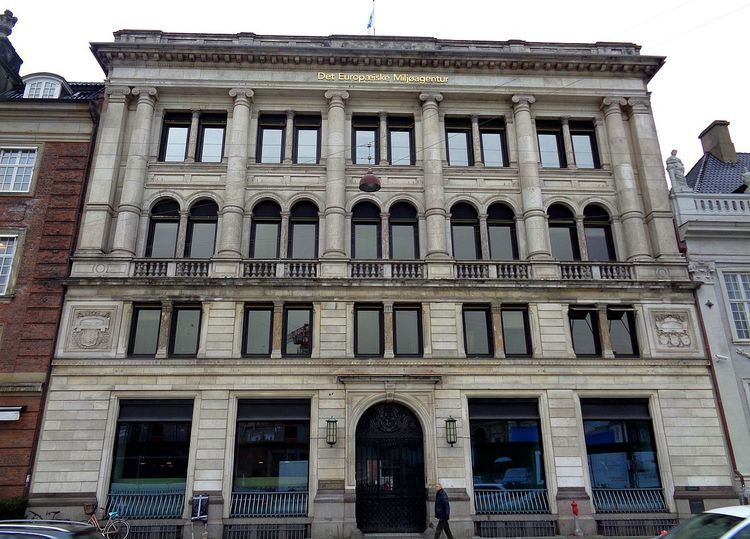Founded 30 October 1993 | Website www.eea.europa.eu Phone +45 33 36 71 00 | |
 | ||
Formed 30 October 1993 (1993-10-30) Agency executives Hans Bruyninckx, Executive DirectorElisabeth Freytag-Rigler, Chairwoman of Management Board Key document Regulation (EC) No 401/2009 Hours Closed now Thursday9AM–4PMFriday9AM–4PMSaturdayClosedSundayClosedMonday9AM–4PMTuesday9AM–4PMWednesday9AM–4PM Similar World Health Organizat, King's New Square, Magasin Du Nord, Sydbank A/S Kongens, The Little Mermaid Profiles | ||
European environment agency presentation
The European Environment Agency (EEA) is the agency of the European Union (EU) that provides independent information on the environment, thereby helping those involved in developing, adopting, implementing and evaluating environmental policy, as well as informing the general public. The agency is governed by a management board composed of representatives of the governments of its 33 member states, a European Commission representative and two scientists appointed by the European Parliament, assisted by a committee of scientists.
Contents
- European environment agency presentation
- European environment agency who we are
- Member countries
- Reports
- European environment information and observation network
- Annual discharge process
- International cooperation
- Official languages
- References
The EEA was established by the European Economic Community (EEC) Regulation 1210/1990 (amended by EEC Regulation 933/1999 and EC Regulation 401/2009) and became operational in 1994. It is headquartered in Copenhagen, Denmark.
The current Executive Director of the agency is Professor Hans Bruyninckx, who has been appointed for a five-year term. He is the successor of Professor Jacqueline McGlade.
The member states of the union are members; however the Council Regulation establishing it provided that other states may become members of it by means of agreements concluded between them and the EU.
It was the first EU body to open its membership to the 13 candidate countries (pre-2004 enlargement).
The EEA has 33 member countries and six cooperating countries. The European environment information and observation network (Eionet) is a partnership network of the EEA and the countries. The EEA is responsible for developing the network and coordinating its activities. To do so, the EEA works closely together with national focal points, typically national environment agencies or environment ministries. They are responsible for coordinating national networks involving many institutions (about 350 in all).
The 33 member countries include the 28 European Union Member States together with Iceland, Liechtenstein, Norway, Switzerland and Turkey.
The six Balkans countries are cooperating countries: Albania, Bosnia and Herzegovina, the Republic of Macedonia, Montenegro, Serbia as well as Kosovo under the UN Security Council Resolution 1244/99. These cooperation activities are integrated into Eionet and are supported by the European Union under the Instrument for Pre-Accession Assistance.
The EEA is an active member of the EPA Network.
European environment agency who we are
Member countries
The 33 member countries include the 28 European Union member states together with Iceland, Liechtenstein, Norway, Switzerland and Turkey. The six Western Balkan countries are cooperating countries: Albania, Bosnia and Herzegovina, the Republic of Macedonia, Montenegro, Serbia as well as Kosovo under the UN Security Council Resolution 1244/99.
Reports
The European Environment Agency (EEA) reported in 2017 that climate-related extreme events accounted ca €400 billion ($430 billion) of economic losses in EEA area from 1980 to 2013, and were responsible for 85,000 deaths during 1980-2013.
European environment information and observation network
The European environment information and observation network (Eionet) is a partnership network of the EEA and its member and cooperating countries. The EEA is responsible for developing the network and coordinating its activities. To do this, the EEA works closely together with the National Focal Points (NFPs), typically national environment agencies or environment ministries in the member countries.
The NFPs are responsible for coordinating networks of the National Reference Centres (NRCs), bringing altogether around 1000 experts from over 350 national institutions and other bodies dealing with environmental information.
Apart from the NFPs and NRCs, Eionet currently covers six European Topic Centres (ETCs) in the areas of air and climate change, biological diversity, climate change impacts, vulnerability and adaptation, water, land use and spatial information and analysis and sustainable consumption and production.
Annual discharge process
On February 2012, the European Parliament's Committee on Budgetary Control published a draft report identifying potential areas of concern in the use of funds and influence for the 2010 budget. The EEA's Executive Director refuted allegations of irregularities in a public hearing
Members of the European Parliament (MEPs) voted on the report on 27 March 2012 and commended the cooperation between the Agency and NGOs working in the environmental area. On 23 October 2012, the European Parliament voted and granted the discharge to the European Environment Agency for its 2010 budget.
On 17 April 2013, the European Parliament (MEPs) voted and granted the discharge to the European Environment Agency for its 2011 budget.
International cooperation
In addition to its 33 members and six Balkan cooperating countries, the EEA also cooperates and fosters partnerships with its neighbours and other countries and regions, mostly in the context of the European Neighbourhood Policy:
Additionally the EEA cooperates with multiple international organizations and the corresponding agencies of the following countries:
Official languages
The 26 official languages used by the EEA are: Bulgarian, Czech, Croatian, Danish, German, Greek, English, Spanish, Estonian, Finnish, French, Hungarian, Icelandic, Italian, Lithuanian, Latvian, Malti, Dutch, Norwegian, Polish, Portuguese, Romanian, Slovak, Slovene, Swedish and Turkish.
